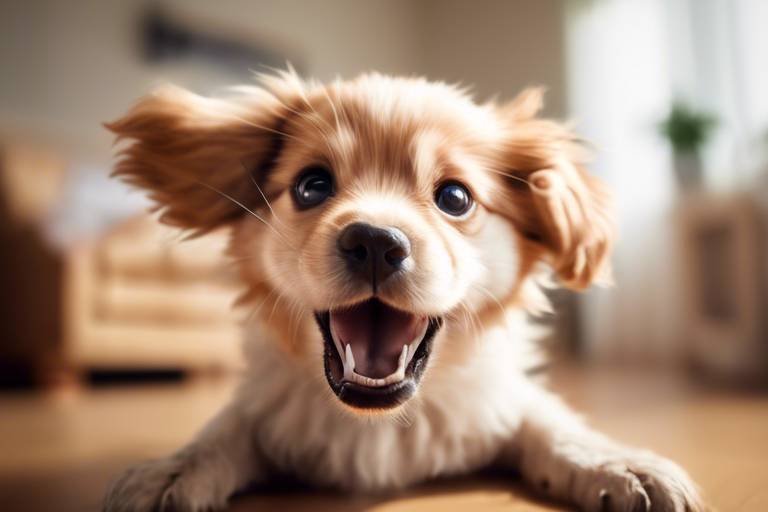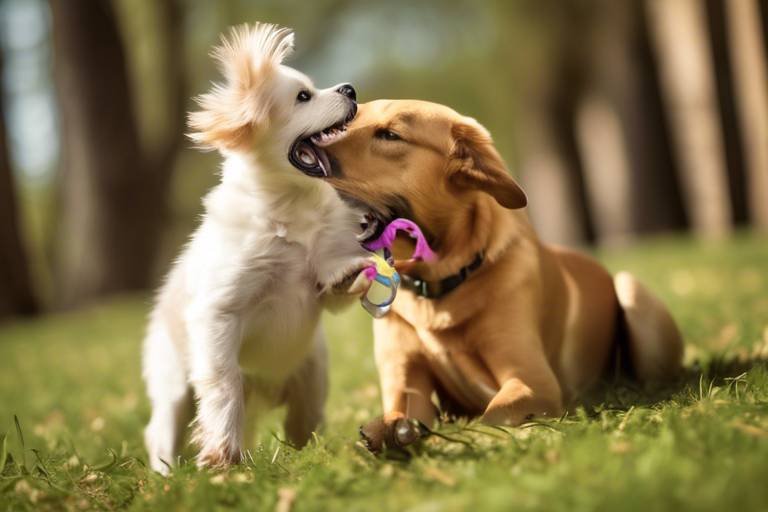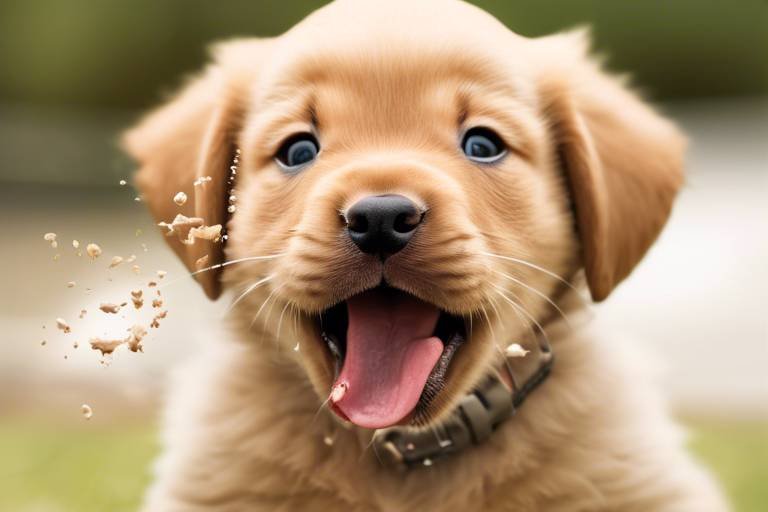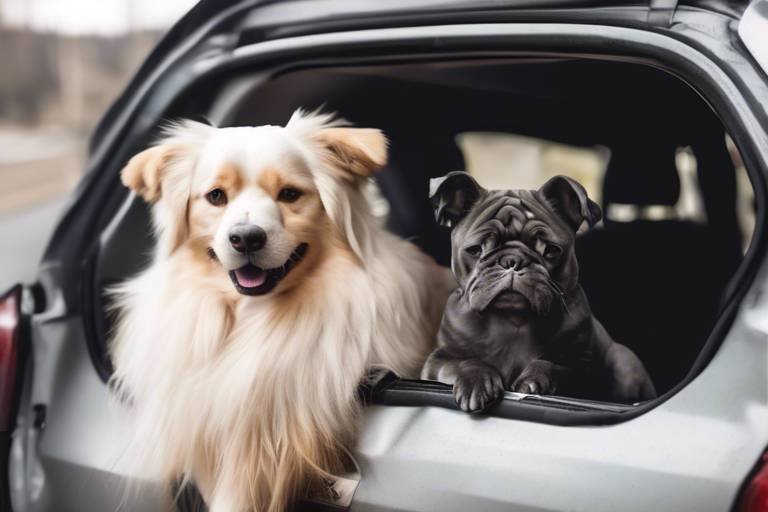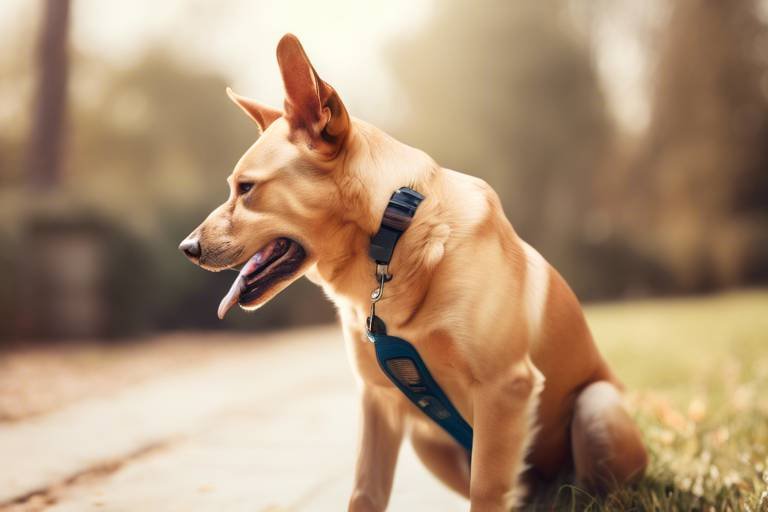How to Train Your Dog to Stay Focused
Training your dog to maintain focus is not just about teaching commands; it's about building a strong bond and understanding between you and your furry friend. Imagine trying to have a conversation with someone who's constantly distracted by their phone or the buzzing of a nearby fly. Frustrating, right? Well, your dog feels the same way when they’re unable to concentrate on you due to distractions in their environment. In this article, we will explore effective strategies and tips that not only enhance your dog's attention but also improve their overall obedience during training sessions. You’ll learn how to recognize distractions, establish a training routine, and utilize positive reinforcement to keep your dog engaged and eager to learn.
Recognizing what distracts your dog is crucial for effective training. Dogs can be easily diverted by a multitude of things, including sounds, smells, and even other animals. For instance, the sound of a doorbell, the rustle of leaves, or the sight of a squirrel can pull your dog's attention away from you. To identify these distractions during training sessions, pay close attention to your dog's behavior. Do they perk up their ears at certain noises? Do they suddenly become fixated on something in the distance? Understanding these triggers will allow you to tailor your training approach. Here are some common distractions:
- Other pets or animals
- People walking by
- Sounds from the environment (cars, sirens, etc.)
- Food or treats on the ground
By being aware of these distractions, you can create a more focused training environment.
Consistency is key in dog training. Just like humans thrive on routine, dogs benefit immensely from having a structured training schedule. Establishing a regular training routine not only promotes focus but also reinforces learning through repetition and positive reinforcement. Aim for short, frequent sessions rather than long, drawn-out ones. This keeps your dog engaged and prevents them from becoming overwhelmed. For example, you might train for 10-15 minutes multiple times a day, focusing on different commands or exercises each time. This approach helps your dog associate training with fun and rewards, making them more likely to pay attention.
The training environment significantly impacts your dog’s focus. Selecting an appropriate space that minimizes distractions is essential for enhancing your dog’s ability to concentrate. An ideal training area is quiet and free from interruptions. If you're training indoors, a room with minimal foot traffic and noise is best. If you're outside, consider a secluded area away from other dogs and people. This allows your dog to focus solely on you and the tasks at hand.
Both indoor and outdoor settings have their pros and cons. Indoor training can offer a controlled environment, but it might lack the excitement and challenges of outdoor training. On the other hand, outdoor training can introduce various distractions, which can be beneficial for teaching your dog to focus in different situations. When adapting your methods, consider the following:
| Environment | Pros | Cons |
|---|---|---|
| Indoor | Controlled environment, fewer distractions | Limited space, less stimulating |
| Outdoor | More stimulating, real-world distractions | Potential for overwhelming distractions |
Ultimately, the choice between indoor and outdoor training depends on your dog's personality and the specific skills you're working on.
Reducing external stimuli is essential for maintaining your dog’s attention. Here are some tips to limit distractions in your training space:
- Choose a quiet time of day for training.
- Close windows and doors to block out noise.
- Use barriers to prevent distractions from other pets.
- Keep training sessions short and engaging.
By creating a distraction-free zone, you’ll enhance your dog's ability to focus on your commands and strengthen your training sessions.
Positive reinforcement is a powerful tool in dog training. This technique involves rewarding your dog for desired behaviors, which encourages them to repeat those behaviors in the future. Whether it’s treats, praise, or playtime, find what motivates your dog the most. For instance, if your dog responds well to treats, use them generously during training. But remember, timing is everything! Reward your dog immediately after they perform the desired behavior to reinforce the connection. This method not only helps keep your dog focused but also builds their confidence and strengthens your bond.
Focus exercises are vital for improving your dog's attention span. Specific exercises can enhance your dog's ability to concentrate on commands and tasks. Start with basic attention commands like "look" or "watch me." These commands teach your dog to direct their focus towards you, setting the foundation for more advanced techniques. Once your dog masters these basics, you can introduce advanced focus techniques that challenge them and keep their minds engaged.
Finally, tracking your dog's progress is essential for effective training. Regularly evaluate your dog's focus improvements and adjust your training techniques as needed for continued success. Keep a training journal to note what works and what doesn’t. This will help you refine your methods and celebrate your dog's achievements along the way. Remember, training is a journey, and every small step counts!
Q: How long should training sessions be?
A: Training sessions should ideally last 10-15 minutes, focusing on different commands to keep your dog engaged.
Q: What should I do if my dog gets distracted during training?
A: If your dog gets distracted, gently redirect their attention back to you and reward them when they focus again.
Q: Can I train my dog at home?
A: Absolutely! Home can be a great training environment as long as you minimize distractions and establish a routine.

Understanding Canine Distractions
When it comes to training your dog, understanding what can distract them is absolutely crucial. Dogs are naturally curious creatures, and their attention can easily be diverted by a variety of stimuli in their environment. Imagine trying to focus on a task while someone is playing loud music or there are interesting smells wafting through the air—your dog experiences a similar struggle! From the sound of a passing car to the sight of another dog, distractions can come in many forms. Recognizing these distractions is the first step in helping your furry friend maintain focus during training sessions.
Some common distractions that might pull your dog's attention away include:
- Sounds: Barking, sirens, or even the rustling of leaves can capture your dog's interest.
- Visuals: Other animals, moving objects, or even people can be significant distractions.
- Smells: Dogs have an incredible sense of smell, and a whiff of something intriguing can easily steal their focus.
- Environment: A busy park or a crowded street can overwhelm your dog with too many stimuli.
To effectively train your dog, it’s essential to identify these distractions during your sessions. Take note of when your dog seems to lose focus and what specifically is causing it. By understanding these triggers, you can tailor your training approach to minimize them. For instance, if you notice that your dog is particularly distracted by other dogs, consider training in a quieter environment where they can concentrate better. This is akin to studying in a library versus a bustling café; the former allows for better focus and retention of information.
Moreover, distractions can vary depending on your dog's personality and past experiences. Some dogs may be more prone to distractions due to anxiety or lack of confidence, while others might be overly curious. As a responsible dog owner, it's vital to observe your pet's behavior and adapt your training methods accordingly. This might involve gradually exposing your dog to distractions in a controlled manner, allowing them to learn how to refocus their attention on you despite the chaos around them.
In conclusion, understanding canine distractions is a fundamental aspect of effective dog training. By recognizing what diverts your dog's attention, you can create a more focused and productive training environment. Remember, patience and consistency are key! As you work together to overcome these distractions, you’ll not only improve your dog’s focus but also strengthen the bond between you and your furry companion.
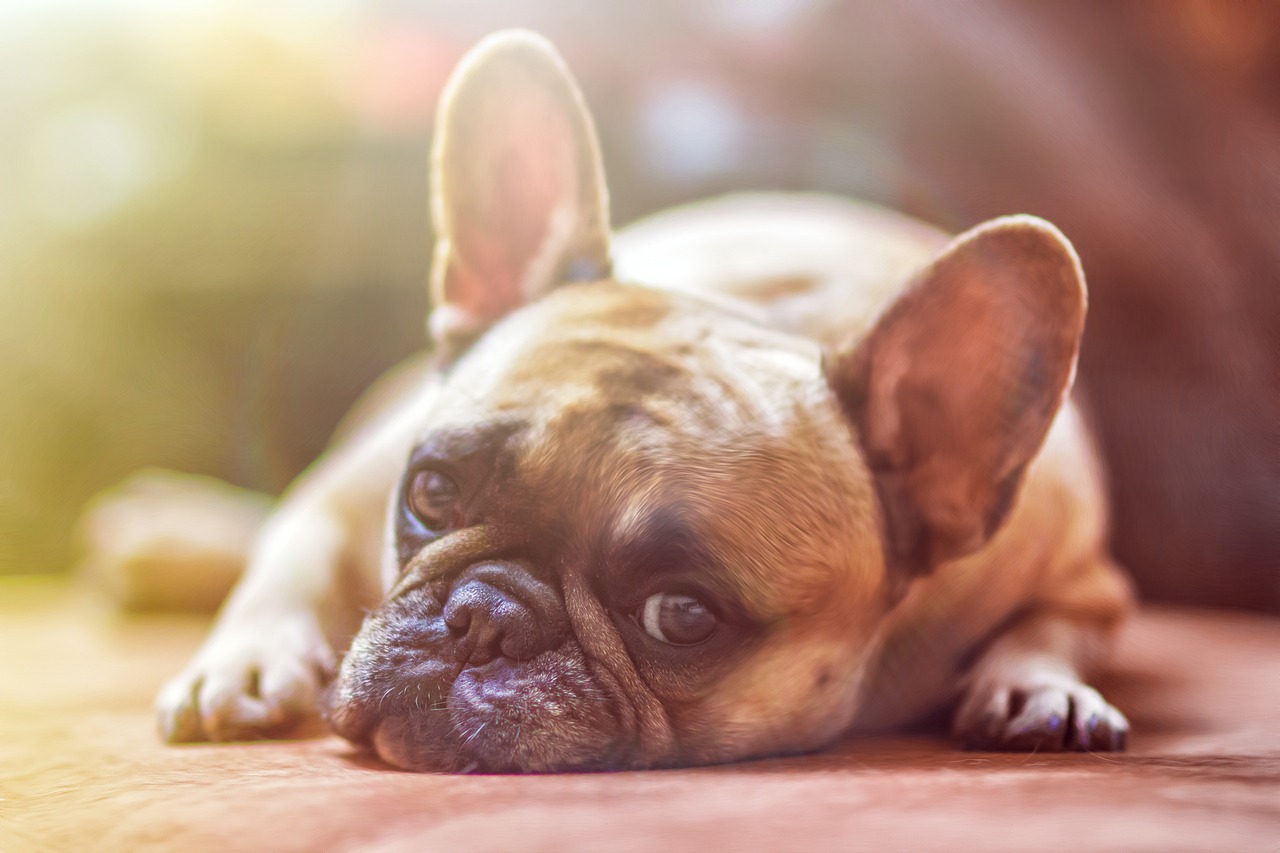
Establishing a Training Routine
When it comes to training your dog, consistency is absolutely key. Just like humans, dogs thrive on routine. Imagine trying to learn a new skill without any structure—it's confusing, right? Establishing a training routine not only helps your furry friend understand what to expect but also sets the stage for effective learning. By incorporating regular training sessions into your daily life, you're not just teaching commands; you're building a bond of trust and communication.
Think of your training routine as a recipe for success. Each ingredient plays a crucial role in achieving the desired outcome. Here are some essential elements to consider when crafting your dog's training schedule:
- Frequency: Aim for short, frequent sessions—around 5 to 10 minutes each. This keeps your dog engaged and prevents boredom.
- Timing: Choose times when your dog is naturally alert and energetic. This could be after a walk or playtime, ensuring they are ready to focus.
- Location: Consistency in location can help reinforce learning. If possible, train in the same spot so your dog associates that area with training.
Additionally, positive reinforcement should be a staple in your routine. Reward your dog with treats, praise, or playtime when they follow commands correctly. This not only encourages them to stay focused but also makes training a fun experience. Imagine the joy on your dog's face when they realize that doing what you ask leads to tasty rewards!
It's also essential to be patient and allow your dog to progress at their own pace. Each dog is unique, and what works for one might not work for another. If your dog seems distracted or overwhelmed, it’s okay to take a step back and simplify the task at hand. Remember, training should be enjoyable for both of you. If you notice that your dog is losing interest, switch things up! Incorporate games or new commands to keep their mind sharp and engaged.
Finally, don’t forget to track your progress. Keeping a journal of your training sessions can help you identify what works and what doesn’t. You might even notice patterns in your dog’s behavior that can inform your training strategy. By regularly assessing your dog’s focus and obedience, you can make necessary adjustments to your routine, ensuring that both you and your furry companion continue to thrive.
Choosing the Right Environment
When it comes to training your dog, the environment plays a crucial role in shaping their focus and attentiveness. Just like you wouldn’t try to study for an exam in a noisy café, your dog needs a space where they can concentrate without distractions. So, how do you pick the right spot for training? Here are some key considerations to keep in mind:
First, think about the level of distraction in your chosen environment. A quiet room in your home can be ideal for initial training sessions, as it allows your dog to focus solely on you and the commands you are teaching. On the other hand, an area with too many noises, like barking dogs or passing cars, can easily divert their attention. To gauge this, observe your dog’s behavior in different settings. If they seem restless or distracted, it might be time to switch locations.
Next, consider the size of the space. A smaller area can help keep your dog close and engaged, especially when teaching new commands. However, as your dog becomes more proficient, gradually moving to larger areas can help them learn to maintain focus amidst greater distractions. This gradual exposure is like training for a marathon; you wouldn’t start by running 26.2 miles on day one, right?
Another factor to consider is the familiarity of the environment. Dogs often perform better in spaces they recognize. For instance, if your dog is accustomed to training in the living room, they may feel more at ease and focused there than in a new park. However, introducing new environments can also be beneficial. It prepares your dog for real-world situations where they’ll need to maintain focus despite unfamiliar surroundings.
Finally, think about the time of day you choose for training. Dogs, much like humans, have their own energy levels. Some dogs are more alert in the morning, while others might be more focused in the evening. Pay attention to your dog’s natural rhythms and schedule training sessions when they’re most likely to be attentive. This could mean a morning session before breakfast or an evening session after a long walk.
To summarize, choosing the right environment for dog training involves a mix of factors that cater to your dog’s unique needs. Here’s a quick recap:
- Minimize distractions by selecting a quiet space.
- Start in a smaller area and gradually increase size.
- Use familiar settings but don’t shy away from new environments.
- Train during times when your dog is naturally more alert.
By carefully selecting your training environment, you set your dog up for success, enhancing their ability to focus and learn effectively. Remember, training should be a positive experience for both you and your furry friend, so choose a space where you can both thrive!
Indoor vs. Outdoor Training
When it comes to training your dog, the environment you choose can make a world of difference. Indoor training and outdoor training each come with their own set of advantages and challenges that can affect your dog's ability to focus. Think of it like choosing between a quiet library and a bustling park; both have their charm, but they cater to different needs. So, how do you decide which setting is best for your furry friend?
Training indoors can be incredibly beneficial, especially if your dog is easily distracted by the sights and sounds of the outside world. An indoor environment allows for controlled conditions where you can minimize distractions. For instance, you can choose a room where the blinds are drawn and the television is off, creating a calm atmosphere that encourages concentration. Moreover, indoor training can be done year-round, regardless of the weather. Rain or shine, your training sessions can continue uninterrupted.
On the other hand, outdoor training presents its own unique benefits. Dogs are naturally curious creatures, and training outside can provide them with a stimulating environment filled with new smells, sounds, and sights. This can be particularly useful for teaching your dog to focus amidst distractions, as it mimics real-life scenarios they may encounter. Imagine your dog learning to ignore a passing squirrel while honing their recall skills! However, outdoor training can also lead to challenges, such as unpredictable distractions like other animals, people, or even vehicles. It’s essential to weigh these factors when deciding where to train.
To help you visualize the pros and cons of indoor versus outdoor training, here’s a quick comparison:
| Aspect | Indoor Training | Outdoor Training |
|---|---|---|
| Distraction Level | Low | High |
| Weather Dependency | Not affected | Affected |
| Control Over Environment | High | Moderate |
| Stimulation | Low | High |
Ultimately, the choice between indoor and outdoor training will depend on your dog's personality and the specific skills you want to develop. If your dog is easily distracted, starting indoors might be the way to go. Once they master commands in a controlled environment, you can gradually introduce outdoor training sessions to challenge their focus further. This gradual exposure can be akin to a child learning to ride a bike; starting with training wheels (indoor) and then moving on to the open road (outdoor) as their confidence grows.
In conclusion, both indoor and outdoor training have their merits, and the best approach often involves a combination of the two. By understanding your dog's needs and preferences, you can create a balanced training regimen that keeps them engaged and focused. Remember, the goal is to make training a fun and rewarding experience for both you and your dog!
- What is the best environment for training my dog? It depends on your dog's personality. Start in a low-distraction environment and gradually introduce outdoor settings.
- How often should I train my dog indoors versus outdoors? A balanced approach is best; try to incorporate both settings into your training routine.
- Can outdoor training be effective in winter? Yes, as long as the weather conditions are safe for your dog, outdoor training can still be beneficial.
Minimizing External Stimuli
When it comes to training your dog, is one of the most critical factors in keeping their attention. Imagine trying to study for an exam while loud music blares in the background; your focus would wane, right? The same principle applies to our furry friends. Dogs are naturally curious creatures, and their attention can easily be diverted by sounds, sights, or even smells in the environment. To create a conducive training atmosphere, it's essential to identify and limit these distractions.
Start by observing your dog's behavior in different settings. Are they more distracted by the sound of traffic, the sight of other dogs, or perhaps the rustling leaves? Once you've pinpointed the common distractions, you can take proactive steps to minimize them. For instance, if your dog gets distracted by passing cars, consider training in a quieter area or during times when foot traffic is low. Similarly, if they are easily distracted by other pets, you might want to train in a space where other animals are not present.
Another effective strategy is to create a designated training zone in your home or yard. This area should be free from distractions—no toys lying around, no family members bustling about, and ideally, a quiet background. You can also use barriers like gates to keep your dog from wandering off and getting distracted by other things. By establishing this space, you signal to your dog that it’s time to focus and learn.
Additionally, consider the time of day you choose for training. Early mornings or late evenings might be the best times to train, as there are typically fewer distractions in the environment. If you can, try to train when your dog is naturally more energetic and alert. This way, they are more likely to engage fully with you and the training commands.
Finally, it’s essential to remain patient and consistent. If your dog gets distracted, gently redirect their attention back to you. Use a calm voice and a firm but gentle hand to guide them. Over time, with practice and repetition in a controlled environment, your dog will start to associate the training zone with focus and learning, making it easier for them to tune out distractions.
By taking these steps to minimize external stimuli, you can create a training environment that fosters focus and enhances your dog's learning experience. Remember, every dog is unique, and what works for one may not work for another. So, stay observant and flexible in your approach!
- How long should I train my dog each day? It's best to keep training sessions short and engaging, around 5 to 15 minutes, to maintain focus.
- What if my dog still gets distracted? If distractions persist, consider changing the training location or time of day, and always be patient.
- Can I use toys as rewards? Yes, using toys can be a great form of positive reinforcement, especially for dogs that are motivated by play.
Utilizing Positive Reinforcement
When it comes to training your dog, positive reinforcement is like the secret sauce that can turn a good training session into a great one! Imagine your dog as a little sponge, soaking up everything you teach them. By rewarding your pup for good behavior, you're not just teaching them commands; you're also building a strong bond based on trust and love. So, how exactly do you harness the power of positive reinforcement?
First off, let’s talk about timing. The effectiveness of positive reinforcement hinges on how quickly you reward your dog after they perform the desired action. If your dog sits on command, make sure to give them a treat or praise immediately after they do it. This helps them associate the action with the reward. Think of it like a game; the quicker the reward, the more motivated your dog will be to play along!
Now, let's dive into the types of rewards you can use. Here are some popular options:
- Treats: Small, tasty snacks are often the go-to choice. Just make sure they’re healthy!
- Praise: Sometimes, a simple "Good boy!" or "Well done!" can be all the motivation your dog needs.
- Playtime: If your dog loves to fetch, use playtime as a reward for good behavior.
- Affection: A good scratch behind the ears or a belly rub can be incredibly rewarding for your pup.
It's essential to choose rewards that resonate with your dog. Some dogs might go crazy for treats, while others might prefer a good game of tug-of-war. Experiment with different rewards and see what gets your dog's tail wagging the most!
Additionally, keep in mind that consistency is vital. If you reward your dog for sitting on command today, make sure to do the same tomorrow and the next day. This consistency helps reinforce the behavior, making it more likely that your dog will repeat it in the future. Over time, you can gradually reduce the frequency of treats as your dog learns the commands, but don’t stop praising them! Your enthusiastic approval is a powerful motivator.
Lastly, remember that training should be a fun experience for both you and your dog. If you find that your pup is losing interest, it might be time to switch things up. Use a mix of different rewards and keep the sessions short and engaging. After all, a happy dog is a focused dog!
- What if my dog doesn’t respond to treats? Some dogs may not be as motivated by food. Try using their favorite toy or extra affection as a reward instead!
- How often should I reward my dog? Initially, reward every good behavior, then gradually reduce the frequency as they learn. Always praise them!
- Can I use negative reinforcement? While some trainers use negative reinforcement, it can lead to fear and anxiety. Positive reinforcement is generally more effective and builds a stronger bond.

Incorporating Focus Exercises
When it comes to training your dog, focus exercises are a game changer! These exercises are designed specifically to enhance your dog's ability to concentrate on commands and tasks, making training sessions not only more effective but also more enjoyable for both of you. Think of focus exercises as the mental gym workouts for your pup; just like us, dogs need to build their focus muscles to improve their overall performance.
One effective way to incorporate focus exercises into your training routine is by starting with basic attention commands. Commands like "sit," "stay," and "look at me" serve as the building blocks for your dog's concentration. When you teach these commands, ensure that you maintain a calm and positive demeanor. Use treats or toys as rewards to encourage your dog to pay attention. For instance, when your dog successfully follows a command, immediately reward them. This creates a positive association with focusing on you, reinforcing the behavior you want to see.
As your dog masters basic commands, you can move on to advanced focus techniques. These techniques can include exercises like the "watch me" command, where you encourage your dog to maintain eye contact with you. This not only strengthens the bond between you and your furry friend but also significantly boosts their attention span. To practice, hold a treat near your face and say "watch me." When your dog makes eye contact, reward them. Over time, you can gradually increase the duration of eye contact required before giving the reward, pushing your dog to focus even more.
Another fantastic focus exercise is the "find it" game. This is a fun and engaging way to sharpen your dog's concentration skills. Start by showing your dog a treat, then hide it while they are watching. After you’ve hidden it, encourage your dog to “find it.” This exercise not only stimulates their mind but also reinforces their ability to focus on a specific task. You can gradually increase the difficulty by hiding the treat in more challenging spots as your dog becomes better at the game.
Incorporating these focus exercises into your training sessions will not only enhance your dog's ability to concentrate but also make training a fun and interactive experience. Remember, the key to success is consistency. Regular practice will help your dog develop the focus they need to excel in training and beyond.
- How long should focus exercises last? Aim for short, engaging sessions of about 5-10 minutes to keep your dog's attention high.
- Can older dogs benefit from focus exercises? Absolutely! Dogs of all ages can improve their focus with consistent practice.
- What if my dog gets distracted easily? Start in a quiet environment and gradually introduce distractions as your dog becomes more proficient.
Basic Attention Commands
When it comes to training your dog, mastering is like laying a solid foundation for a house. Without this strong base, everything else can crumble. These commands not only help your dog focus but also enhance your communication with them. Think of it as building a bridge of understanding between you and your furry friend. The essential commands to start with include "sit," "stay," "come," and "look."
The command "sit" is often the first command taught because it’s simple and effective. When your dog learns to sit, they're also learning to stop what they’re doing and focus on you. To teach this command, you can use a treat to guide their nose upwards, causing their bottom to lower naturally. Once they sit, reward them immediately. This immediate reinforcement helps them associate the action with a positive outcome.
Next is the "stay" command. This command is crucial for maintaining your dog's focus, especially in distracting environments. Start by having your dog sit, then take a step back while saying "stay." If they remain in place, reward them with a treat. Gradually increase the distance and duration of the stay. This command not only keeps your dog in one spot but also teaches them patience and self-control.
The command "come" is essential for safety and recall. It’s a command that can literally save your dog’s life. To teach this, start in a quiet environment with minimal distractions. Call your dog’s name followed by "come," and when they approach you, reward them with treats and lots of praise. Make sure to practice this command regularly, as it builds reliability over time.
Lastly, the "look" command is a fantastic way to capture your dog’s attention. This command can be particularly useful when your dog is distracted. To teach this, hold a treat near your face and say "look." When your dog makes eye contact, reward them. This not only reinforces their focus on you but also establishes a deeper connection, as they learn to seek your attention.
Incorporating these basic attention commands into your training routine will undoubtedly improve your dog’s focus. Remember, consistency is key! Practice these commands in various environments to help your dog generalize their understanding. Over time, you’ll notice a significant improvement in their ability to concentrate, making training sessions smoother and more enjoyable for both of you.
- How long does it take to teach basic commands? - The time it takes to teach commands varies by dog, but with consistent practice, many dogs can learn basic commands within a few weeks.
- What if my dog doesn’t respond to commands? - If your dog isn’t responding, check your training environment for distractions and ensure you’re using positive reinforcement effectively.
- Can I train my dog without treats? - Yes! You can use toys, praise, or playtime as rewards, but treats are often the quickest way to reinforce learning.
Advanced Focus Techniques
Once your dog has mastered the basic commands, it's time to level up the training with some . These methods not only challenge your furry friend but also significantly enhance their concentration skills. Think of it as taking your dog’s mental workout to the next level! Just like humans, dogs thrive on challenges that keep their brains engaged.
One effective technique is the “Look at Me” command, which reinforces eye contact between you and your dog. Start by holding a treat near your face and saying “Look at me!” When your dog makes eye contact, reward them immediately. This simple exercise can be practiced in various environments, gradually introducing more distractions as your dog becomes proficient. The goal here is to create a strong connection that helps your dog focus solely on you, even when the world around them is bustling.
Another advanced technique is the “Find It” game. This game is not only fun but also encourages your dog to use their nose and brain, which can enhance their focus. Begin by showing your dog a treat and then hiding it while they watch. Once it's hidden, command them to “Find it!” This exercise sharpens their focus and encourages them to ignore other distractions. As they get better, you can increase the difficulty by hiding treats in more challenging locations.
Incorporating distraction training is also crucial for advanced focus. This involves exposing your dog to various distractions while practicing commands. For instance, have a friend walk by with their dog or play a recording of loud noises while you ask your dog to sit or stay. The aim is to reinforce their ability to focus on you despite external stimuli. Start with mild distractions and gradually increase the intensity as your dog becomes more adept at maintaining focus.
Lastly, consider using duration training. This technique involves asking your dog to hold a command for an extended period. For example, ask them to “stay” while you gradually increase the time before rewarding them. This not only builds their focus but also teaches them patience. You can make it more challenging by gradually increasing the distance between you and your dog while they maintain the command. Remember, consistency is key, and always reward progress!
In summary, advanced focus techniques are essential for building a strong bond between you and your dog while enhancing their ability to concentrate. These exercises not only make training fun but also prepare your dog to handle distractions in real-life situations. The more you practice, the more focused and obedient your furry friend will become!
- How long should I practice advanced techniques with my dog?
It’s best to keep training sessions short and engaging, around 5-10 minutes per exercise, to maintain your dog's interest and prevent fatigue. - What if my dog gets distracted easily?
Start in a low-distraction environment and gradually introduce distractions as they improve. Patience and consistency are key! - Can I use toys instead of treats for rewards?
Absolutely! Many dogs respond well to their favorite toys, so feel free to mix it up based on what motivates your dog best.
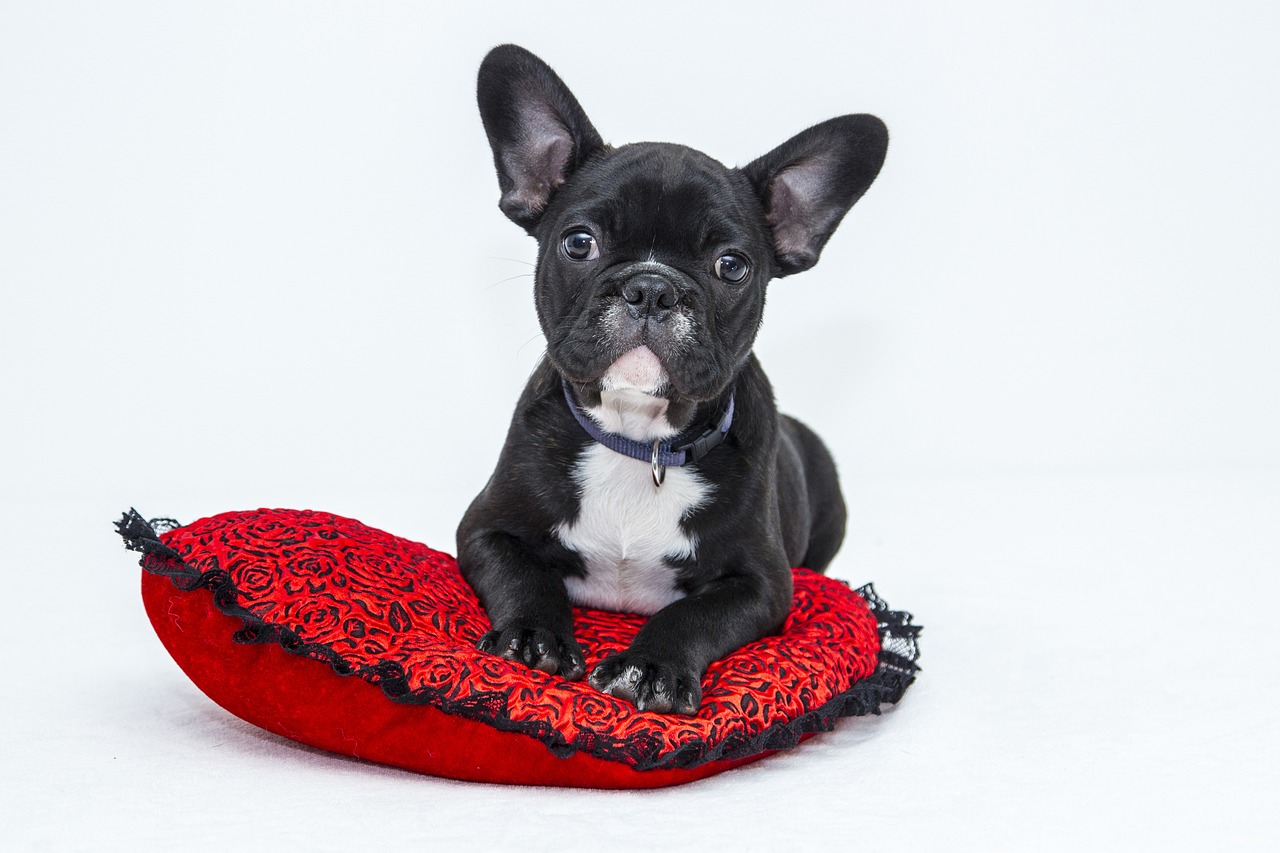
Monitoring Progress and Adjusting Techniques
Tracking your dog's progress is not just beneficial; it’s essential for effective training. Think of it as a roadmap guiding you and your furry friend toward greater focus and obedience. By regularly assessing how well your dog is responding to various commands and distractions, you can make informed decisions about your training approach. So, how do you monitor this progress? Start by keeping a detailed training journal. This can be as simple as a notebook or a digital document where you jot down notes after each session. Record the commands practiced, the environment, and your dog's responses. This will not only help you see patterns but also highlight areas needing improvement.
In addition to your journal, consider using a simple rating system to evaluate your dog's focus level during training. For instance, you might rate their attention on a scale from 1 to 5, where 1 indicates complete distraction and 5 shows full engagement. This can help you visualize their progress over time. Here’s a quick example of what that might look like:
| Training Session | Date | Focus Level (1-5) | Notes |
|---|---|---|---|
| Basic Commands | 2023-10-01 | 4 | Good focus, slight distraction from other dogs. |
| Focus Exercises | 2023-10-08 | 3 | More distractions present; needs improvement. |
| Advanced Techniques | 2023-10-15 | 5 | Excellent focus, completed all tasks. |
As you analyze this data, you may notice trends that can inform your training methods. For example, if your dog consistently struggles with focus in certain environments, it may be time to adjust your training location or the techniques you’re using. Perhaps you need to minimize distractions further or switch up your rewards to keep your dog engaged.
Don’t forget to celebrate the small victories! Recognizing your dog's achievements, no matter how minor, can boost their confidence and motivation. A simple “good job” or a favorite treat can go a long way in reinforcing positive behavior. On the flip side, if you notice that your dog is becoming frustrated or disinterested, it’s crucial to adapt your approach. This could mean shortening training sessions, changing the focus of the exercises, or even taking a break to reset their attention.
Ultimately, the goal is to create a training experience that is both effective and enjoyable for your dog. By continuously monitoring their progress and adjusting your techniques, you can foster an environment that encourages focus, learning, and a strong bond between you and your pet. Remember, patience and flexibility are key in this journey!
- How long should training sessions be? Short, frequent training sessions of 10-15 minutes are usually most effective for maintaining focus.
- What should I do if my dog seems disinterested? Try changing the environment, using different rewards, or taking a break to refresh their focus.
- How can I tell if my dog is making progress? Keep a training journal to track their responses and focus levels over time.
- Is it normal for my dog to have off days? Yes, just like humans, dogs can have days when they are less focused or motivated.
Frequently Asked Questions
-
What are some common distractions that can affect my dog's focus?
Dogs can be easily distracted by a variety of stimuli, such as other animals, loud noises, moving objects, or even the smell of food. Identifying these distractions is crucial to help you create a focused training environment. Pay attention to what typically draws your dog's attention away during training sessions, and work on minimizing those distractions.
-
How often should I train my dog to improve focus?
Consistency is key! Aim for short, frequent training sessions—about 5 to 15 minutes each, several times a day. This helps reinforce learning and keeps your dog engaged without overwhelming them. Remember, it’s better to have multiple short sessions than one long one.
-
Is it better to train indoors or outdoors?
Both environments have their pros and cons. Indoor training can minimize distractions, making it easier for your dog to focus. However, outdoor training can expose your dog to real-world distractions, helping them learn to maintain focus in various situations. The choice depends on your dog's comfort level and the specific training goals you have.
-
What are some effective positive reinforcement techniques?
Positive reinforcement can include treats, verbal praise, or playtime. The key is to reward your dog immediately after they exhibit the desired behavior so they can associate the action with the reward. Experiment with different rewards to see what motivates your dog the most!
-
Can you give examples of focus exercises for dogs?
Absolutely! Start with basic attention commands like "sit" and "stay," then progress to more advanced techniques such as "watch me" or "leave it." You can also incorporate games like hide-and-seek to enhance their focus while making it fun!
-
How can I monitor my dog's progress during training?
Keep a training journal to track your dog's performance. Note any improvements or setbacks, and adjust your techniques as needed. Regularly assessing their focus during different exercises will help you understand what works best for them and where they might need more practice.



